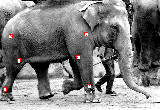 update 02/20/2000
update 02/20/2000


For 124 kB MPEG video click elephant image
For Giraffe MPEG video click here
Motion studies with large mammals and dinosaurs
Within a cooperation of the University of Bochum (Ruhr-Universitaet, Anat.
Inst., Funktionelle Morphologie), the F.I.B.U.S. research institute, and
the Krefeld zoo a motion study at elephants has been performed to provide
information on efficiency of locomotion of heavy animals like dinosaurs
or elephants.
While popular movies like the well known "Jurassic Park" movie
suggest that exact data on those primeval animals already exist, different
research teams come to completely different conclusions about important
data like mass and maximum speed of the dinosaurs. For the Brachiosaurus
the maximum body mass ranges from 40 to 70 tons, according to the researchers.
Looking at the maximum speed it is even worse: while one research team claims
very fast running speed of 61 km/h for the Stegosaurus, the other team
came to a maximum of only 7 km/h.
It is evident that we have to learn more about live conditions and efficiency
of dinosaurs. It can be expected that we obtain interesting information
on handling of large body mass from this investigation. As real live experiments
with dinosaurs are difficult to perform nowadays, it was decided to use
elephants for the experiments. It is assumed that elefants with a weight
of several tons can at least give some information on the motion conditions
of large dinosaurs.
Due to the kind cooperation of the Krefeld zoo and especially with the help
of elephant trainer W. Nehring it was possible to record motion sequences
of the walking and running elephants.
The sequences were recorded directly into the memory of the picCOLOR image
analysis system to provide high spatial resolution. All joints at the legs
of the elephant were marked by round white stickers. During the post analysis
the sticker position has been tracked with subpixel accuracy. Vectorized
joint positions were output to file for analysis of joint acceleration.
First results show that the former theories that elefants use their legs
like passive pendulums to save energy are not correct. Instead they use
a very simple trick by lifting their hips for acceleration of the pendulum
motion. The analysis shows an increased acceleration of about two times
the earth acceleration for the leg after loosing contact of the ground from
the rear position. According to this result it is evident that the maximum
speed estimate has to be newly formulated. The very low speeds, postulated
by various research teams, can't be valid anymore.
More data at different running speed of the elephant will be analysed in
the future to obtain more accurate and reliable results. Additionally the
touch down of the foot will be analysed at high accuracy. By analyzing the
touch down case of the foot we can learn a lot about how the elephant handles
deceleration and damping of his large body mass.
 ...Back to FIBUS Home Page ...Back to FIBUS Home Page |
Copyright © 2003 The
FIBUS Research Institute, Dr. Reinert H. G. Mueller;


 update 02/20/2000
update 02/20/2000
